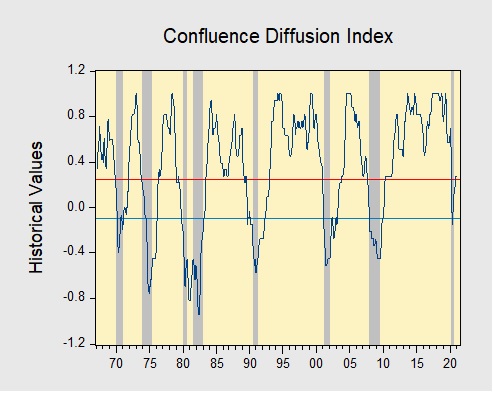Business Cycle Report (February 25, 2021)
by Thomas Wash | PDF
The business cycle has a major impact on financial markets; recessions usually accompany bear markets in equities. The intention of this report is to keep our readers apprised of the potential for recession, updated on a monthly basis. Although it isn’t the final word on our views about recession, it is part of our process in signaling the potential for a downturn.
In January, the diffusion index rose further above the recession indicator, signaling that the recovery continues. Financial markets were mixed as investor optimism about the economy and rising inflation concerns resulted in stronger equities and wider yield spreads. Meanwhile, the labor market worsened due to new COVID-19 restrictions, forcing firms to lay off workers. That being said, manufacturing activity continues to be a bright spot in the economy as factories were able to avoid many of the new restrictions. As a result, four out of the 11 indicators are in contraction territory. The reading for January was unchanged from the previous month at +0.2727, above the recession signal of +0.2500.
The chart above shows the Confluence Diffusion Index. It uses a three-month moving average of 11 leading indicators to track the state of the business cycle. The red line signals when the business cycle is headed toward a contraction, while the blue line signals when the business cycle is headed toward a recovery. On average, the diffusion index is currently providing about six months of lead time for a contraction and five months of lead time for a recovery. Continue reading for a more in-depth understanding of how the indicators are performing and refer to our Glossary of Charts at the back of this report for a description of each chart and what it measures. A chart title listed in red indicates that indicator is signaling recession.



